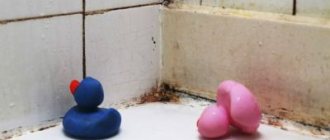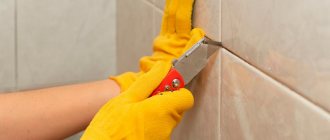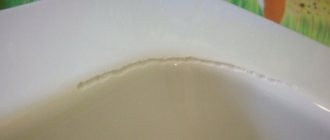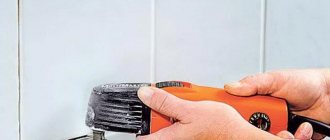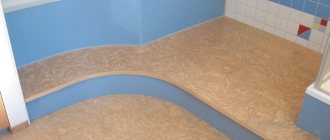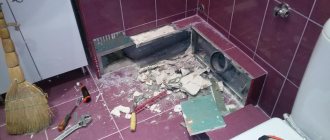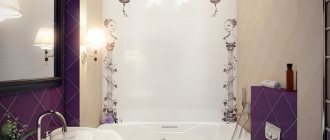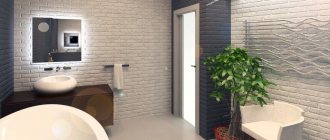Fungus can appear in the bathroom, the wettest and warmest room in the house. The danger of mold mycelium is not only that it worsens the appearance of the room, but also that it can lead to a number of diseases associated with deterioration of the immune system.
The first signs of bacterial damage include fatigue, nausea, poor health, frequent headaches, cough, and skin rash. And in order to avoid sad consequences, you need to quickly combat the fungus. After carrying out a set of appropriate measures, you can get rid of this trouble forever.
Fungus in the bathroom: why is it dangerous?
Causes of fungus
Of all the rooms, the bathroom is the most vulnerable. The climate that forms here provides favorable conditions for the development of the fungus. And if there are no characteristic dark spots in the new house or apartment, it’s just a matter of time. As soon as the humidity level rises and the functionality of the ventilation system deteriorates, the fungus will immediately make itself known. What is typical is that the type of surface does not matter - it can be either painted concrete or modern plastic.
Why does black mold appear?
The best place for mold spores to grow is the washing machine.
Mold in the washing machine
All its corners, inaccessible and damp, can be confidently called true breeding grounds for fungus. In principle, spores are constantly present in the home, but only bloom under favorable conditions.
Table. Why does fungus develop?
| Cause | Short description |
| High humidity (more than 90%) | If we talk specifically about the bathroom, there is no way to get rid of humidity unless you simply stop visiting this room. After each water procedure, condensation forms on the surfaces of the room (ceiling, walls, etc.), which contributes to the spread of fungus. |
| No antiseptic treatment | If, during finishing, you do not treat the room with special compounds in a timely manner (or do not treat it at all), then the mycelium will easily settle on the walls, in various kinds of joints (including between tiles) and other places. |
| Lack of natural light | Without windows in the bathroom, the lack of natural ultraviolet light can lead to the development of fungus. The fact is that UV rays have a detrimental effect on it. |
| Heat | If the temperature in this room exceeds +20°C, then the likelihood of fungus appearing increases significantly. |
| Poor/no ventilation | If the diameter of the ventilation opening is insufficient or the exhaust air ducts are clogged, air circulation will be disrupted. Humid air will remain in the room instead of leaving it. And this is also one of the provoking factors. |
When at least one of the listed conditions occurs, thin lines of mold mycelium appear on all wet surfaces and begin to multiply quite quickly. Almost everyone is probably familiar with the characteristic dark gray pattern, accompanied by a musty smell. If nothing is done in the early stages of fungus development, then over time the plaster, paint and other finishing layers will begin to peel off, and cracks will form on the concrete surface. After this, all consequences can be eliminated only through repairs.
How to deal with mold
As previously noted, only with an integrated approach can the problem under consideration be solved. Simple mechanical removal of the damaged surface will not lead to the desired result. To get rid of black mold you should:
- Install good ventilation. When considering the main causes of mold, many people pay attention to the fact that the bathroom often does not have effective ventilation. The hood allows you to not only remove air with high humidity from the room, but also spores. It is worth considering that the common method of removing moisture, which involves simply opening the door, will not cope with the task.
- Spores can hide in furniture and plumbing fixtures. An example is the lower rim of a washbasin or bathtub. Mechanical cleaning in case of severe damage to the material does not always give the desired result, since spores can penetrate deep into the structure of the material. Therefore, the only and correct solution will be to completely replace the furniture.
- Dampness provides favorable conditions for the proliferation of a wide variety of microorganisms. Therefore, the fight against dampness can be called a responsible step. A situation often occurs when condensation forms on a sewer riser or water supply pipe. It causes the formation of not only rust, but also microorganisms. If pipes and adapters are installed incorrectly, connections can leak, as can the locking mechanisms themselves. Therefore, you should check the connections of all inlet and outlet pipes and replace outdated locking mechanisms.
- High humidity can be combated by insulating surfaces. An example is the use of moisture-resistant paint, which will not allow moisture to penetrate the structure of many materials.
The biggest challenge arises when removing mold directly. For this purpose, special means are used, as well as mechanical influence. As previously noted, pores can become strongly embedded in various materials. When using special cleaning agents, mechanical cleaning should only be done while wearing protective clothing.
Why is fungus in the bathroom dangerous?
The habitat of mold mycelium is very diverse. This can be not only brick or concrete, but also various paint and varnish coatings. Sometimes the fungus is difficult to notice at all, because it can even develop under the tiles.
Actively developing, he can:
- destroy building materials, which can lead to possible collapse of the structure;
- worsen the aesthetic properties of the finish;
- pose a danger to human health.
Regarding the last point, the spores enter the respiratory organs, which can lead to the development of:
- asthma;
- allergies;
- other serious diseases (including joint damage).
It is for this reason that at the first signs of fungal development it is necessary to take urgent measures.
Fungus in the bathroom: a dangerous neighborhood
Chemicals
Living in rooms with fungus is dangerous. Mold spores enter the lungs and onto the skin, causing various diseases. You can fight fungi in different ways.
Abedis 06
Dilute 1:2. A liter of the drug per 2 liters of water. Due to the chlorine in the composition, wear gloves before working. Harmful to health. Use with caution after reading the instructions. Apply with a brush or roller overnight. Afterwards, rinse with water.
Biotol spray
Clean the affected surface before applying biotol. Then use a spray bottle to spray the product onto the areas. If the fungus penetrates deeply, the treatment must be repeated. Biotol is safe. There are no toxic substances in the composition.
Biotol spray - anti-mold agent
Biotsid-S
Dilute the drug with water 1:3. It contains chlorine. Before work, put on gloves and a mask.
The biocide is used in medicine.
It is used to disinfect surfaces.
Dali
The cleaner is applied to any surface: wood, ceramics, concrete, tiles, brick. Versatile, highly effective. Destroys all types of fungus. Has a pungent odor. Before use, wear protective clothing and goggles. Fights algae and moss.
Universal antiseptic Dali against mold and mildew
Mavix-Bio
Domestic manufacturer's drug
Expensive, but effective. Buy with a water repellent. Impregnation is purchased as a kit. Use it to lubricate the affected areas before work. Afterwards, apply Mavix. The validity period is indicated in the instructions. After a few hours, remove the mold. Then treat the areas with a water repellent. This is the final point that protects surfaces from water and dirt.
Folk remedies
Instead of chemicals, you can resort to home remedies.
- Ammonia. Dilute with water 1:1. Apply using a spray bottle. Then wipe with a rag or towel. They will absorb the remaining moisture. If necessary, repeat the procedure. Wait 3-4 hours. Clean and dry the surface with a cloth.
- Borax. Hazardous to health. Wear gloves. But the product does not emit toxic fumes. Pour 2 cups of the substance into a five-liter bucket of water. Treat infected areas, then rinse with water.
- Hydrogen peroxide. Use a three percent solution. Spray with a spray bottle until completely saturated. A toothbrush is also used. After waiting 20 minutes, clean out the mold and rinse with water. Dry with a towel.
- Bleaching. Apply to any surface: tiles, wood, enamel, glass. For 1 part of substance – 10 parts of water. Due to toxic substances, wear gloves, goggles, and a respirator before working. Apply to areas with a spray bottle. Bleach eats away the color. The substance is not suitable for all surfaces.
- Vinegar. Versatile. Fights against any type of mold. Apply by spray. After 15 minutes, the surface is cleaned with a medium-soft brush. Then it is washed off with water. Ventilate the room after work.
At the first appearance of the fungus, you need to get rid of it urgently
Important points of the process
Let’s immediately make a reservation that you should get rid of not the visible signs of damage, but directly from the source of the problem. The visible part is dark spotting, and the focus is the mycelium (the latter is what needs to be removed). Look for the hearth not on the surface, because it is often hidden deeper, in a more humid and less lit place - in various voids, under the finishing material.
To remove a layer of mold mycelium, use a regular scraper - scrape off the affected areas with it.
Spatula-scraper
Also clean the seams between the tiles if they are damaged and remove all grout.
Removing grout from tile joints
If the tile is about to fall off, it means that a breeding ground is also hidden in it - remove it and treat the exposed surfaces.
How to remove tiles in the bathroom
All further actions must be carried out in a dry room. For this reason, arm yourself with a hair dryer (it’s convenient for heating cleaned areas) or, if you don’t have one, use a regular household heater.
General appearance of a construction hair dryer with its names of individual parts
After drying everything, start fighting the fungus using special means (more on them later). It is very important to comply with safety requirements, so use protective equipment when working.
Protective means
Dose the selected drug in accordance with the manufacturer’s instructions (or one of those presented in this article).
The last step of the work is to reheat the room.
Black mold in the bathroom - what is the reason and how to get rid of it?
Black mold is the collective name for a number of different types of higher mold fungi, some of which can cause serious illness in humans and animals.
These include representatives of the genera Ulocladium, Cladosporium, Alternaria, Stachybotrys, Aspergillus, Penicillium, Chaetomium, Phoma, Wallemia. Most often, black aspergillus (Aspergillus niger) appears on the walls of damp rooms, including our bathrooms, the spores of which are extremely dangerous to human health.
Toxic compounds contained in microscopic mold spores pose a danger to humans. The spores settle in the lungs, are absorbed through the skin and end up in food. If after brushing your teeth you feel an unpleasant aftertaste of mold in your mouth, it means that your toothbrush is infected with fungus and should be replaced immediately.
The most common habitats for black mold are bathrooms (tile joints, shower stalls, ceilings, sealant, contaminated surfaces), basement walls, new buildings with poor ventilation systems, and room walls with damp wallpaper. Surprisingly, 1 m2 of mold produces hundreds of millions of microscopic spores per hour, providing a high degree of survival and permanent suppression of the immune system of the person who inhales them. Due to constantly high levels of humidity, bathrooms are the first at risk of black mold infestation.
With prolonged exposure to the human body, black mold can cause a number of diseases:
- Respiratory diseases: asthma, pneumonia, sinusitis, dry cough
- Skin rashes
- Stomach upset
- Headache
- Nosebleeds
- Internal bleeding
- Kidney and liver damage
- Emphysema Mycosis (mold poisoning)
Thus, when black mold appears in residential premises, it is not for nothing that it causes concern among their owners. But, in fairness, it is worth noting that various types of black fungi can grow in apartments, and not all of them are equally dangerous to humans, and some of them are completely harmless. The type of mold and the degree of pathogenicity of its spores also depends on the material on which it grows. But, unfortunately, only an experienced biologist or disinfectant can determine the type of mold growing in your bathroom, and often only through expensive tests. And since there is an extremely high probability that the fungus that has settled in your apartment is dangerous to health, you should immediately begin to eliminate the reasons that led to its appearance and the areas directly affected by it.
Reasons that contribute to the germination of black mold spores:
- Increased level of humidity in the room. Remedy: Improve bathroom ventilation. Do not cover the ventilation hole with PVC panels, drywall or tiles. Provide fresh air access to the bathroom from outside. Special holes made in the door serve this purpose. If there are no holes, you should keep the door ajar at all times. An exhaust fan can be installed in the ventilation hole, but it should cover no more than half of the ventilation duct outlet. It is worth mentioning that a fan can only remove humid air when the bathroom door is open, and if it is tightly closed, the fan is useless. Without access to fresh air from outside, the fan cannot create the vacuum needed to remove the moist air. Fresh air enters other rooms from open windows. Even if the bathroom door is open and the windows are closed, the missing air will come from the neighbors below through the kitchen ventilation duct. It is absolutely unacceptable for the bathroom fan to turn on and off at the same time as the light. After taking a shower, the fan should run for another 2-3 hours with the door open and run periodically the rest of the time.
- Dirt deposits on the seams and joints of the shower cabin or bathtub. Elimination: Remove dirt using special cleaning agents and detergents. With regular care, there is a chance to avoid mold growth. You should also remove nutrient media favorable for spore germination: wood, paper, potting soil, bare concrete, etc.
- Presence of mold spores in the air. Remedy: Almost irreparable. Mold spores can be transported by airborne droplets and enter the apartment on people, animals, food and things. The only way to combat it is to prevent the humidity level in the room from rising above 60%, and then mold spores simply will not be able to germinate.
- New construction methods and materials, due to which new buildings lack the necessary level of air circulation and moisture is retained in the premises, artificially increasing the humidity level. Elimination: The only way is to constantly ventilate the premises, modernize the existing ventilation system and regularly repair leaks of any kind. Even if there are mold spores in the air and on various surfaces, in the absence of the required level of humidity, spore germination will not occur.
Removing mold from affected areas yourself
It only makes sense to fight mold on your own if the affected area does not exceed 0.5 m2. If the affected area exceeds 0.5 m2, then the hyphae (“roots”) of the mold have penetrated too deeply and only a specialist can remove them. Any superficial removal of mold in this case will lead to even greater spread of spores and re-germination from the remaining hyphae. Remember, the later you start dealing with mold, the less chance you have of success. Any removal operations should be performed with gloves and a respirator.
To remove mold, even the highest quality product alone is not enough!
It is also necessary to create a protective layer on the treated surface. For independent control of mold, Tikkurila HOMEENPOISTO has proven itself well. You just need to moisten the affected area with it, after half an hour, rinse it with water and wipe the cleaned area with a damp sponge. Repeat the procedure several times at the intervals specified in the instructions.
For a more effective fight, it is better to use finishing repair materials containing antiseptics and fungicides in combination with anti-mold agents. For example, if mold has settled in seams filled with silicone sealant, it should be carefully removed and replaced with a new one containing antifungal substances (fungicides).
Remember that it is useless to fight the fungus until the causes of its appearance are identified and eliminated.
When called, disinfectors perform a range of mold removal work in the following order:
- Identifying the causes of mold and its source. If possible, during the initial examination using diagnostic equipment, otherwise (if large areas are affected), a mycological examination is carried out. In most cases, the causes are determined upon examination; if large areas are affected, then a mycological examination is usually indispensable.
- Eliminating the causes of mold. Fighting fungus makes no sense without identifying and eliminating the causes of its appearance.
- Radical destruction of mold and its spores. Cleaning surfaces (removing paint, wallpaper and plaster). Concrete and wood are milled. Direct removal of mold by treatment with special chemical compounds (at least 2 at each facility). Heat treatment and professional equipment are also used to destroy spores.
- Mold protection. Application of a protective coating to prevent relapse (long-lasting). Finishing work. To eliminate the possibility of relapse, fungicides are added to building materials to prevent the recurrence of mold.
Usually the work takes no more than 2 days, since each of the compounds is applied separately. The time it takes to complete the work varies and depends on the specific situation.
What is needed to combat fungal infection?
Before starting work, you should take care of everything necessary, in particular, your safety (many of the means listed below are extremely aggressive).
In the fight against fungal infection, you will definitely need:
- spray;
- latex gloves;
- eye protection glasses;
- respirator (required when using products containing chlorine);
- capacity;
- brush or small brush;
- putty knife;
- actually, remedies for mold mycelium.
Tools and materials to combat mold in the bathroom
After preparing everything you need, you can get down to business.
Safety rules when processing premises
All mold removal procedures are considered dangerous types of work, since when they are performed, harmful fungal spores can come into contact with the skin and mucous membranes.
In addition, when treating surfaces, mostly potent substances are used, which can cause burns, poisoning and other negative reactions.
It is better to carry out all work wearing personal protective equipment to prevent mold spores and aggressive chemicals from entering the respiratory system.
To prevent this, it is necessary to take special precautions.
When carrying out work you should wear:
- durable rubber gloves that protect your palms and wrists;
- respirators or respiratory masks;
- plastic glasses (preferably special ones that fit tightly to the eye sockets) that provide effective eye protection.
After completing the work, it is recommended to throw away the protective equipment used, primarily gloves and respirators.
When treating a bathroom, it is better to remove all small objects from the room, and cover large ones with a protective film, which should then be carefully collected and taken out.
Measures to destroy the fungus must be carried out in the absence of children and pets. It is advisable to ventilate the treated room well for 2-4 hours, after which it is better not to use the bathroom for 2-3 days.
Removing fungus in the bathroom correctly
If a fungus is detected, all necessary measures should be taken to avoid its reappearance. So follow the instructions below.
Step 1. Remove areas of fungal growth. Clean them, dry them, and then cover them with special products (more on them later).
Step 2: Improve ventilation efficiency. First, check the ventilation shaft for blockages. Clean it if necessary. If everything is in order there, but the fungus still appears, it means that the existing ventilation is not enough and you need to add a fan.
How to check ventilation operation
Step 3. Remove all old bedside tables from the bathroom, as they are probably also subject to fungal infection.
Step 4. Carefully inspect the washing machine, because, as noted earlier, it is an ideal place for fungus to develop.
Step 5: Inspect the pipes. If a lot of condensation accumulates on their surface, then they are most likely not insulated enough.
Condensation on pipes in the bathroom
Insulation of pipes as a method of combating condensation
If the pipes are metal, then it is better to install plastic ones instead (there is guaranteed to be no condensation on the latter).
Piping in the bathroom
Step 6 . Bring to life all plumbing equipment. Water should not drip from the faucet or shower.
Step 7. Install a high-quality heated towel rail and, if possible, a “warm floor”. The fact is that the temperature in the bathroom should be at least 2-3°C higher than in other rooms - in such conditions the moisture will quickly evaporate.
Step 8. Insulate the outer wall of the bathroom, if you have one.
Step 9: Refinish the entire room.
Step 10. Buy and place dehumidifiers in the room. If you can't do this, then at least fill several small containers with salt and place them in different places.
Desiccants
However, the most important step is still the actual removal of the fungus. If this procedure is not performed carefully enough, then additional measures will not give any result.
Types of black mold
Mycelium looks like fluffy growths or stains of a black hue
. What is popularly called black mold combines different types of microscopic fungi. They feed on dead organic matter, reproduce by spores, and settle on personal hygiene items, food, and furniture. Outwardly they look like stains or spots of dark shades (black, gray, greenish), upon closer examination they resemble cotton wool or velvety fabric. Pathogenic microorganisms multiply at an incredible rate, making it impossible to control their growth. The growth of black mold is caused by about three hundred strains of fungi, which are divided according to the degree of health hazard.
Aspergillus niger is a strain of fungus that appears more often than others in residential areas
Table 1. Strains of fungi that cause black mold growth.
| Fungus strain | Characteristics |
| Aspergillus niger | Saprophytes, which are common in places with high humidity. In apartments they grow on the surfaces of bathrooms, kitchens, damp book spines, washing machines, and air conditioners. Has an increased health hazard |
| Alternaria tenuis | The color of the mycelium depends on the growth conditions. Pathogenic microorganisms “love” overripe or rotten fruits, but they are also found on wooden surfaces. Causes serious harm to the human body |
| Aspergillus fumigates | Fungi attack damaged fruits and vegetables, but under favorable conditions they live on suitable residential surfaces. They do not pose a serious danger to a healthy person, but are harmful to children, allergy sufferers, and people with reduced immunity. |
| Penicillium | The spores are used in the manufacture of medicines and elite varieties of cheese. Fungi often live near humans and are practically harmless, but some strains belong to risk groups 3 and 4 |
| Cladosporium | Found in open areas and in buildings, some species feed on fuels, lubricants or other chemicals |
| Chaetomium | It occurs infrequently in residential areas, but poses a fatal danger if it enters the digestive tract - there are cases of death known to medicine |
Attention! It is impossible to distinguish safe fungi from pathogenic ones by appearance, so dark stains on surfaces must be dealt with in any case.
Homemade remedies for fungal infection
To remove fungus you need to use all available methods; You can, for example, use improvised means, which include:
- copper sulfate;
- bleach.
You can also purchase special antifungicidal drugs, but first things first.
We use a solution of copper sulfate
Step 1: Put on a respirator and rubber gloves. Don't forget that copper sulfate is very toxic.
Step 2. Prepare the solution: take 100 g of the substance, add it to 10 liters of water and mix thoroughly.
How to dilute copper sulfate to treat walls against mold
Step 3. Using a brush, apply the prepared solution. It is advisable to treat those surfaces where there is no fungus for preventive purposes.
Step 4. Leave the room for 2-3 hours.
Step 5. Rinse all treated surfaces with clean water and then wipe dry.
Step 6. Ventilate the bathroom.
We use bleach
Bleach is also effective against fungus, although the smell is unusually pungent. Protective equipment - a respirator with gloves - is required.
Step 1 . Dilute bleach in water (1:10).
Liquid bleaches
Step 2. Apply the solution to the damaged areas using a sponge or sprayer.
Bathroom Mold Removal
Step 3 . Ventilate the room.
It is worth noting that this product does not need to be rinsed off. It will not be visible, and the presence of bleach will prevent further development of the fungus.
Traditional methods of mold removal
Since mold fungi have bothered residents for centuries, and household chemicals began to be produced not so long ago, the population has accumulated extensive experience in using a variety of means to destroy harmful microflora.
Image gallery
Photo from
Step 1: Selection of components for preparing the product
Step 2: Preparation of the anti-fungal composition
Step 3: Apply Anti-Mold Repair
Step 4: Carefully finishing the finishing seams
Among the most common drugs that have a pronounced effect are the following.
Option #1 – copper sulfate
An inexpensive, effective product that can be purchased at gardening, construction or hardware stores. Blue crystals are diluted in warm water in the proportion of 200-300 grams of powder per 10 liters of liquid, after which they are mixed well.
The process of treating the affected surface with the prepared solution is carried out in several stages:
- Traces of mold on the walls are cleaned using sandpaper or a spatula.
- The prepared areas are wiped with soapy water, which increases the effectiveness of the product used.
- The cleaned and washed surface is given time to dry.
- The wall is treated with copper sulfate (the solution can be applied using a kitchen sponge or sprayer).
- The surface is left to dry for 3-5 hours, after which diluted vitriol is again applied to it.
- Depending on the degree of fungal damage, the procedure is repeated 2-5 times.
For greater effectiveness, you can additionally add a tablespoon of vinegar to the vitriol solution.
Option #2 - chlorine-containing products
Solutions containing chlorine guarantee effective destruction of mold: they contain an aggressive component that kills most microorganisms. To combat fungus, you can use popular chlorine-containing preparations, which are often used in the household to bleach fabrics or clean plumbing fixtures, namely Domestos , Belizna , Sanita and others.
Products containing chlorine have a pronounced antifungal effect. However, they cannot be used simultaneously with ammonia to avoid a reaction
To combat mold colonies, the affected areas and the area around them are treated with a cloth moistened with undiluted product.
To treat tile joints, the preparation can be diluted with water in a 1 to 1 ratio, poured into a spray bottle and applied to the seams.
Option #3 – table vinegar
Almost every home has a 6-9% vinegar solution, which is widely used in cooking. At the same time, this product is a good antiseptic that perfectly destroys various types of microflora.
To combat mold you should:
- treat the affected area with table vinegar: just wipe a smooth surface (tile) with a sponge or rag dipped in liquid, and spray loose coatings (plaster, concrete, wood) with a spray bottle;
- leave the treated surface for 2-3 hours until dry;
- remove any remaining fungus with a brush;
- rinse cleaned areas thoroughly with water;
- Ventilate the room well to remove the pungent odor.
It should be borne in mind that in some cases vinegar may leave streaks on the wall.
Other folk remedies for fungus
In addition, the following drugs can be used as antibacterial and fungicidal agents:
- Hydrogen peroxide . A widely used antiseptic, a 3% solution of which can be purchased at a pharmacy. The drug is non-toxic and has no pronounced odor. Caution is required during processing as peroxide has a clear bleaching effect.
- Ammonia. A good product for removing mold colonies from dense hard surfaces such as ceramic tiles or glass. To destroy microflora, the drug purchased at a hardware store is diluted with an equal amount of water, after which the mixture is applied to the infected area using a sponge or sprayer. The solution is left on the wall for several hours, after which the coating is washed well.
- Baking soda . A natural and safe household antiseptic that will help fight fungus. For treatment, a solution of a teaspoon of powder mixed in a glass of water is used. The surface on which the fungus is noticed is sprayed with the solution, or the wall is washed with a sponge soaked in the composition. It is not necessary to wash off the soda; you can safely leave it on the tiles or other surface.
- Tea tree oil . An environmentally friendly product with a strong, pleasant aroma, suitable for the prevention and destruction of small areas of mold. To use, you need to dissolve two teaspoons of essential oil in half a liter of water, which can be purchased at a pharmacy or specialty store. The resulting solution is sprayed onto areas where fungus is suspected. The product should not be washed off, but after treatment it is better not to enter the bathroom for 12 hours.
- Creosote . A yellowish liquid with a pungent odor made from tar is used as a solution in alcohol or ether. The product is recommended to be applied to concrete, tiles, plastic panels, bricks and other smooth, dense surfaces. After the product has dried, it must be washed off with soap and water. It is not advisable to use creosote to treat wooden structures, since the solution instantly penetrates into loose textures.
- Anthracene oil . A greenish liquid with a specific odor is produced from coal. Oil is considered a good prophylactic agent that prevents mold from appearing on walls.
- Borax . A mineral that is a natural antiseptic. To treat a surface with sprouted mold, you need to prepare a solution of 2.5 liters of liquid and 1 cup of borax. After cleaning the wall from stains, a fairly thick composition is applied to it using a rag. There is no need to rinse it off, but after drying, you can wipe the surface with dry paper to remove any protruding crystals. Another option: make a less concentrated solution (a full glass of borax and 4 liters of liquid), and then spray the affected area with a spray bottle.
- Camphor balls. To prevent fungal infection, camphor balls can be placed indoors.
- Iodine . Another preventive measure is iodine vapor. To do this, place a glass of water on a shelf in the bathroom, in which 10 mg of regular iodine tincture is diluted. It is advisable that there are no metal objects nearby, as volatile iodine vapors can cause corrosion.
Don't forget about cleaning cocktails.
A combined method can be used to treat moldy stains. The surface should be treated with soda or soda solution, and then moistened with table vinegar. After the foam settles, the remaining product is washed off with soapy water.
A preparation made from 4 parts water, 2 parts hydrogen peroxide, 1 part boric acid, 2 parts vinegar is also considered an effective remedy.
All components are mixed well, after which a rag or sponge is moistened with the mixture, which is used to treat all affected areas.
Effective folk remedies
Not everyone uses chemicals. Some are allergic to these drugs, others simply do not recognize them, so traditional methods are still very popular.
Common Methods
All of the following remedies are often used separately, but they can be combined for greater effectiveness.
Vinegar and soda. Apply a thick layer of baking soda to the affected areas and pour vinegar over them. Once the foam has settled, clean the surfaces with warm soapy water.
Antifungal agents: baking soda and vinegar
Tea tree oil. Dissolve 2 teaspoons of oil in 500 ml of warm water. Pour the prepared solution into a spray bottle. Treat surfaces. There is no need to rinse off the product after treatment.
Tea tree oil
Hydrogen peroxide combined with boric acid. Mix acid, vinegar, peroxide and water (required ratio 1:2:2:4). Apply the resulting solution to the affected areas.
Hydrogen peroxide against mold
Note! After work, it is advisable to leave an open pack of soda in the room. The fact is that soda effectively absorbs unpleasant odors.
Borax
Dilute borax in water (1 glass per 2.5 liters), apply the resulting product after cleaning the surfaces. You don’t have to wash it off, but be sure to wipe the treated areas with paper.
Borax against mold in the bathroom
Camphor balls
Effective only in the initial stages of fungal infection. Place the balls around the room when the first signs of fungus appear.
Camphor balls
Creosote
Creosote will help get rid of serious foci of fungal development. Dissolve creosote in alcohol and treat the desired areas. Remove any leftovers as they are hazardous to health. Typically, creosote can only be used on brick and concrete surfaces.
Video - Folk remedies for mold (fungus) in the bathroom
How to avoid high humidity
Before removing fungus from the bathroom, it is necessary to create conditions under which its reappearance would be impossible. Of course, the air temperature cannot be changed, therefore, it is necessary to reduce the humidity. To do this, you need to check for leaks or places where water accumulates. Often a small crack in a pipe causes a puddle of water that won't dry out and is out of sight, for example, under the bathtub or in the corner behind the washing machine. Accordingly, if leaks are detected, they must be eliminated.
The necessary air circulation in the bathroom is achieved in the traditional way - using an exhaust ventilation device, while an additional fan can be installed in the hood
The second thing to do is to improve ventilation. The air must circulate freely in the space of the room; for this there are exits to the ventilation shafts. If natural ventilation is impaired, you should think about installing forced ventilation, for example, installing a special device in the ventilation opening. Also, do not turn the bathroom into a dryer - in this case, the appearance of mold is guaranteed. Preventive measures will protect walls and furniture from fungus, and residents from diseases.
Sanitation, ionization
Directing a stream of air, which is enriched with ions and microelements, into the affected areas using a special device will help get rid of fungus on the ceiling. But this procedure is carried out only by specialists who have completed the appropriate courses. In addition, it will cost a considerable amount.
Air purifier, ionizer, ozonizer Fresh Air
Fungus on wooden surfaces
The most difficult thing to remove is fungus that has grown on wood surfaces. And if you notice cotton-like formations, remove them immediately and treat the areas with a special solution. If the wooden parts are badly damaged, replace them.
Fungus on wood - photo
A 3% solution of potassium fluoride is quite effective. You can dilute it in water (20 g per 1 liter), mix thoroughly and apply the resulting product to the affected areas.
Prevention of black mold
Myceliums are found behind the rubber seal of the washing machine
To prevent mycelium from appearing in your home, you need to follow simple sanitary and hygienic rules.
- Regularly check the ventilation, clean the duct of dirt, debris, dust, ventilate the premises even in winter (mold is “afraid” of dry air and low temperatures). In summer, it is recommended to keep the curtains open to allow as much sunlight as possible into the room.
- Control the humidity level in the apartment. To do this, you can purchase a special device - the humidity level should remain within 70-80%. If the readings are too high, the cause must be determined and eliminated.
- Check plumbing fixtures. Inspect the plumbing equipment (toilet, taps, mixers), identify leaks, and eliminate malfunctions. Mold often grows inside old pipes, so it is better to replace them.
- Rearrange your apartment. It is recommended to move cabinets, sofas and other pieces of furniture slightly away from the walls so that air can circulate normally and the surfaces do not become damp.
- Monitor the quality of the products. Spoiled food should not be kept in the house, much less eaten - moldy bread or fruit should be placed in a plastic bag and disposed of.
- Clean regularly using antiseptic agents. Organic residues left on surfaces provide food for molds. To prevent the appearance of mold, you need to regularly wet clean your apartment using antiseptic agents. It is especially important to clean the kitchen, bathroom, and toilet. All corners need to be treated, even the farthest ones, as well as the washing machine. To prevent the appearance of mold, it is enough to use a solution of soda once a month - a tablespoon per glass of water.
Mold is a dangerous neighbor that can cause serious health problems. You can cope with it with the help of special antiseptics, and if preventive measures are taken, the fungi will leave the house forever.
We recommend reading our article - how to remove fungus in the bathroom: on the walls between the tiles, on the sealant - step-by-step instructions and popular advice.
Fungus on tiles
A lot here depends on how far the mold has spread.
If it is present only on the surface, then:
- dissolve any product in water;
- take a sponge and wash off the fungus.
In case of greater penetration of microspores (for example, they are located between the tiles), take more serious measures.
Step 1. Using a putty knife, remove the grout.
Step 2. Dry the surfaces with a hairdryer.
Step 3. Treat the joints twice with an antiseptic.
Step 4. Grout the seams with new grout, adding an antiseptic.
Antifungal grout "Kesto" with antiseptics
Epoxy grout for joints Litokol Starlike Litoc
If the fungus has settled under the tiles, then only radical measures will help. You can also invite specialists who, knowing how to determine the strain of the fungus, will help with the selection of the most effective remedy.
Additional measures and rules when combating mold
Note! Another effective method in the fight against fungus between tiles is the use of a blowtorch or quartz lamp. Read how to install a bathtub correctly on the website.
Liberating the territory from invaders
The mycelium is a living colony that cannot be wiped off with a wet rag. How to remove fungus in the bathroom so that it does not appear again? The answer to this question largely depends on how badly the surfaces are damaged by mold. To destroy microorganisms, all means are good: they use both industrial compounds and drugs that are folk inventions.
The first step before choosing a method of combating a fungus is an adequate assessment of the damage and removal of lesions.
- If large accumulations of fungus are found in the bathroom, “filling” the wallpaper or plaster, then the top layer of material must be removed.
- When stains appear only on tile joints, they are first sanded over with sandpaper, and the clean material is treated with a protective compound.
- A seam affected to its full depth is a rarity, but such a phenomenon is a good reason for the ruthless elimination of all grout.
- If a silicone sealant protecting the joints between the wall and the bathtub is attacked by a fungus, it is completely removed, and the base is cleaned of fungus and treated.
- When mold is found on the tiles in the bathroom, it is washed off and the facing material is thoroughly wiped with a special solution.
- The plastic panels that decorate the ceiling and walls are dismantled to process the grooves. The walls under the cladding must be treated.
Surfaces from which all facing materials affected by the fungus have been removed are first generously moistened with water to interrupt further possible flight of spores. Then the walls and/or ceilings are treated with a stiff brush or metal scraper. Then wash thoroughly, ventilate and dry. At the same time, many are engaged in arranging effective ventilation. The next stage is repeated treatment (at least 2-3 times) of all surfaces with disinfectants. Each layer must be left until it dries.
Precautionary measures
All stages of work are carried out in full uniform: rubber gloves, goggles and a respirator are required. To get rid of bathroom invaders forever, you need to remove all small objects from the room, and cover large ones with a film that will protect them from the ubiquitous spores. After finishing work, it is better to throw away all protective equipment immediately.
Sometimes very serious lesions occur. In such cases, it is advisable to contact specialists. They have at their disposal many tools that make it easy to determine the type of threat, and therefore find the best ways to get rid of it.
Additional ways to “genocide” fungi
To ensure the success of the mold eradication operation, other weapons are used:
- treatment with an ultraviolet lamp, it is destructive for the fungus, but it is better to remove people, plants and animals from the bathroom;
- an ionizer checker (the active substance is silver ions), when burned, the fungal spores safely die.
Since this enemy has been known for a very long time, quite a lot of ways to fight it have already been invented/thought out.
